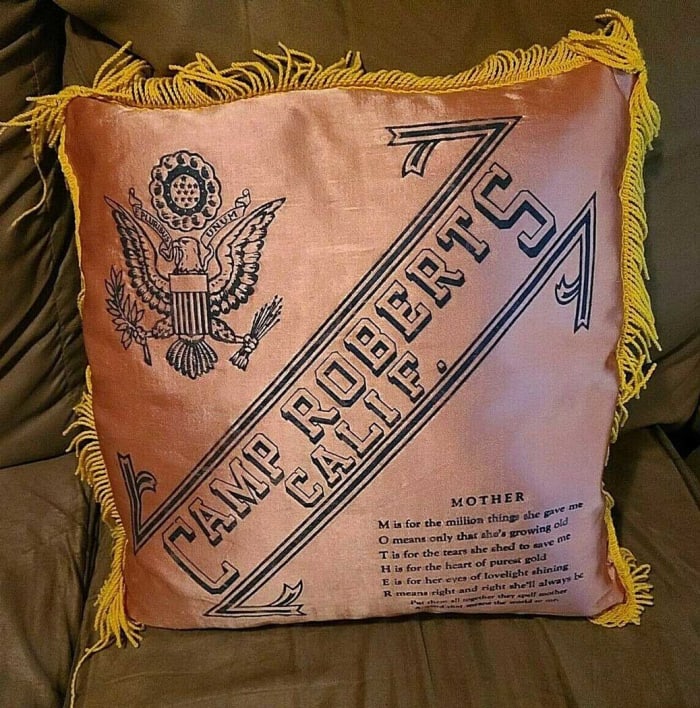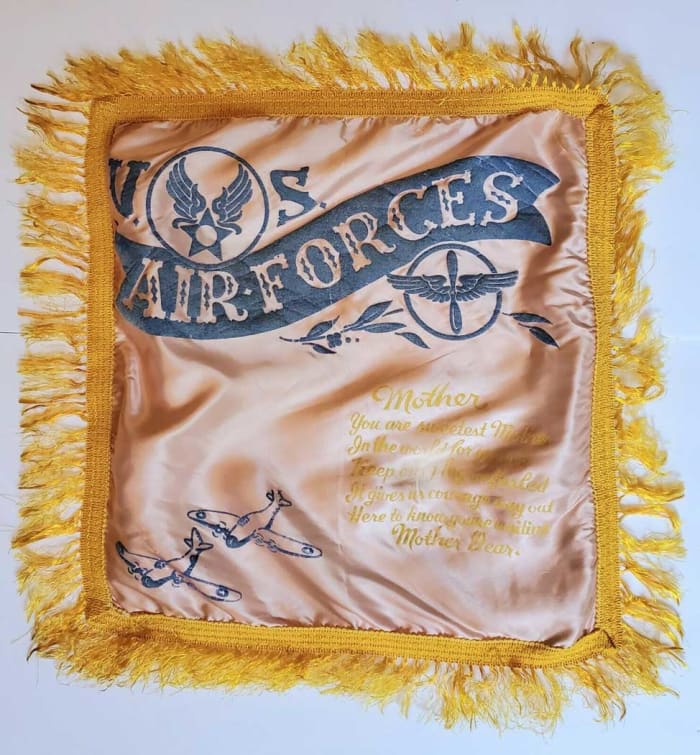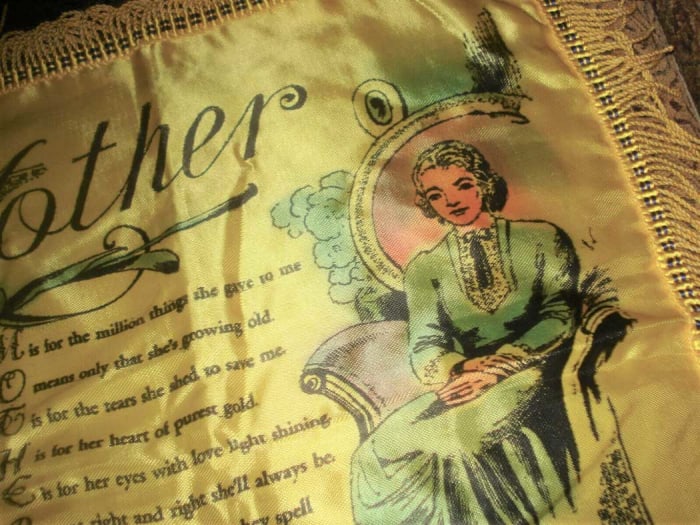One of the earliest “Mother” pillows known dated to the War of 1812. At that time, one Abner McDonough of Wilmington, Delaware, was a private in the U. S. Army, stationed in Washington, D. C., almost on the eve of the siege of the capital by the British. In a letter sent to his mother dated August 12, 1813, he wrote:
“Some of us fellows took ahold [sic] of a good idea, Sunday week, which has led us to make special remembrances for our loved ones back home. We was wondering what to do with the sacks the feed for the mules comes in, and they’re being a lull in the fighting hereabouts and us having some time free for achange [sic], we got us some needles and coloured threads and sewed words of true sentiment, and designs too, on the sacks, then stuffing them with pine needles and sewing up the end. My pillow is for you, it says SWEETEST MOTHER, and has two harts [sic] on the ends. You will get it soon, as Johnny Adams of the 3rd reg. gets his discharge tomorrow and will deliver it to you …”
Sadly, most likely the next letter Mrs. McDonough received was from the War Department telling her of her son’s death.
During the Civil War, it was a relatively common routine among soldiers from both the North and South to mail battlefront tokens back home. “Mother” or “Sweetheart” pillows made up a number of those souvenirs. These pillows usually followed the template defined above by Pvt. McDonough.

A vintage ‘Mother’ pillow from Camp Roberts, California. Inscribed on the pillow: ‘MOTHER: M is for the million things she gave me; O means only that she’s growing old; T is for the tears she shed to save me; H is the heart of pure gold; E is for the eyes of lovelight shining; R means right and right she’ll always be.’ Value: $17
Courtesy eBay
Even though the Spanish-American War lasted for just under eight months “Mother” pillows were being sent home to the soldier’s mothers. But during this time most of these pillows were mass produced and put on sale on military bases. These “Mother” pillows manufacturers were not small mom and pop businesses but made and sold in large numbers by commercial companies.
It was America’s entry into World War l that opened the floodgates to the manufacture and sale of the vintage “Mother” pillows we see today. The Federation of American Retailers of Felt Products and Novelties (FARFPAN) published statistics that reveal 12.3 million “Mother” pillows were sold during the period 1917-20. After that three-year period, sales fell off but during the four years from 1941-1945 sales picked up again; 11.7 million were sold.

Vintage WWII U.S. Army Air Forces ‘Mother’ pillow cover, approximately 17″ x 17″. Value: $12.
Courtesy eBay
These “Mother” pillow covers pique the interest of both vintage textile and military memorabilia collectors. Once received at home from their soldier sons, the pillows were often framed and hung on the wall or were put away in a chest of drawers. Some found their way onto the sofa as throw pillow coverings. Although today, “Mother” pillow coverings may be deemed by some, when a mother received the distant gesture of love, she was quite happy to know her son held her in high regard.
As time went on the prose affixed to the pillow covers became more dewy-eyed. It wasn’t only soldiers who were serving away from home who sent the pillow covers home but a number of young men toiling for the Civilian Conservation Corps camps sent “Mother” pillows home.

Vintage ‘Mother’ pillow case with poem, satin with fringe, approximately 17″ x 17″. Value: $12.
Courtesy eBay
The reason U.S. Military personnel seemed to embrace the “Mother” pillow covers was because some might never see home and family again. The pillow covers were a soldier’s way of sharing a sort of remembrance with family. This resulted in many of these pillows featuring a rhyming love poem, like the following:
Mother:
Each petal represents a flower
Each bud a kiss for you,
Each stem an arm entwined about
My Mother, dear and true.
During World War I ‘Mother’ pillows were made of silk and during World War ll the pillows were usually of rayon or acetate
Sources:
Bulkley, Liz, “Pillow Talk & War: A Review” The Forum, January 28, 2012
Cummings, Patricia, Sweetheart & Mother Pillows, 1917-1945 (Schiffer, 2011)
D’Huart, Elizabeth, “Honoring Mom During World Wars I And II,” Benicia Historical Museum Apr 28, 2015.
Henry, Lyell, D., “The Significance of ‘Mother’ Pillows in American History and Culture,” Journal of Popular Culture
You May Also Like:
Mom Depicted in Antiques & Collectibles









